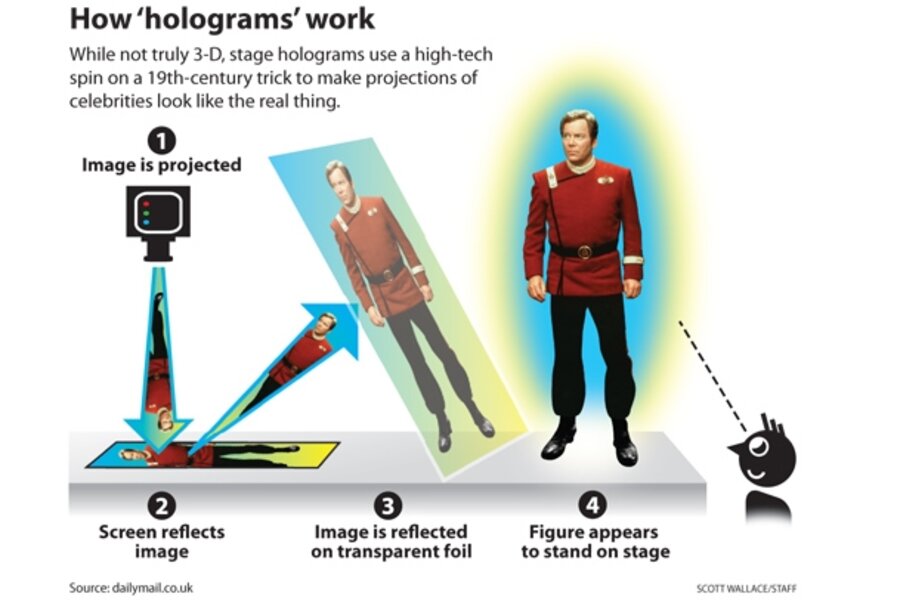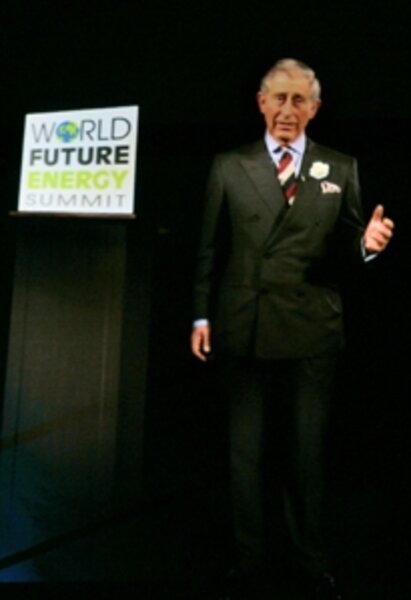Holograms, live onstage
Loading...
The image is iconic: Princess Leia, clad all in white, pleading for Obi-Wan Kenobi’s help via hologram.
Since it first appeared in 1977, this scene from “Star Wars” has epitomized the idea of holographic teleconferencing.
Thirty years later, such 3-D projections have mostly remained as science fiction.
While they have been used to great effect in movies and TV shows, 3-D holograms have been too costly and too technologically complex for practical use. But that may be changing.
Projection technology has advanced to the point where it is now feasible, although still expensive, to use so-called “stage holograms” for telecommunication.
“The technology for doing this exists,” says Paul Debevec, associate director of Graphics Research at the University of Southern California’s Institute for Creative Technologies in Marina del Rey, Calif. “In the next five to 10 years, I expect some real breakthroughs.”
Several celebrities have already made holographic public appearances, including Microsoft chairman Bill Gates, former vice president Al Gore, soccer star David Beckham, and Virgin Group chairman Richard Branson.
Beyond the cool factor, these holograms help the environment – a benefit regularly pointed out by those who use them.
Britain’s Prince Charles gave a speech in hologram form at a green energy conference in Abu Dhabi last year. During the prerecorded presentation, the virtual Prince of Wales stressed that, had he flown to the conference in person, he would have emitted around 15 tons of carbon dioxide.
“I am now going to vanish into thin air, leaving not a carbon footprint behind,” said the prince at the end of his speech.
These onstage holographic appearances appear nearly identical to the real thing. The images are to scale. They move naturally. Only the occasional light flicker reminds the audience that they’re watching a projection. It’s far subtler than the sputtering blue and white holograms that pop up in “Star Wars” movies.
Not quite holograms
There is a slight hitch. These high-definition images may seem like holograms, but, technically speaking, they’re not. They’re more like “two-dimensional billboards,” Mr. Debevec says.
Although they appear to be 3-D from the audience’s perspective, the images are actually as flat as a cardboard cutout.
To truly be a hologram, “different people should be able to see the image from different viewpoints and have it appear exactly like a person would appear from those angles,” Debevec says.
These flat images are created by employing a modern version of a 150-year old visual trick known as “Pepper’s ghost.” Used by Victorian magicians to create stage illusions, the trick projects an image at a 90-degree angle onto a transparent but reflective surface, usually glass, mounted at a 45-degree angle. The result is an image that appears to be 3-D.
Telecommunications giant Cisco and the hologram wizards at Musion Systems in London updated Pepper’s ghost for the 21st century.
The new project, called On-Stage TelePresence, replaces the lights and glass with mylar screens, high-definition cameras, and fiber-optic networks. (See graphic, page 13.)
They demonstrated TelePresence in late 2007 by allowing Cisco chairman John Chambers to share a stage in Bangalore, India, with his colleague, Marthin de Beer, who was in San Jose, Calif., at the time. The two men appear to be standing side-by-side, chatting, and reacting to each other’s movements.
Ian O’Connell, operations director at Musion, says that he’d like to see such stage holograms enable teachers to beam into classrooms at understaffed schools, chart-topping entertainers to perform in stadiums while simultaneously appearing in smaller venues, and mega-church pastors to preach to community congregations.
The virtual boardroom
Cisco has sold to several companies teleconferencing technology that uses hologram-like images to create virtual conference tables. Executives in two different buildings sit down at tables outfitted with high-definition cameras and monitors. The systems captures one-half of a table and streams the images into the other building.
The resulting compilation creates the illusion that the two half-tables are a whole and that all the participants are gathered in the same place.
“The principle is most similar to that of a webcam,” says Mr. O’Connell. “It’s a stationary, head-and-shoulders view of people seated at a table view.”
David Hsieh, Cisco’s vice president of emerging technologies, says that creating full-size 3-D images for concerts or boardrooms is possible, but complicated. The problem is science.
Light has to bounce off something in order for human eyes to see the image. Scientists have developed several workarounds to create truly 3-D images, including mist, intersecting lasers, and spinning mirrors. But these techniques are too complex for regular use, Mr. Hsieh says.
Right now, the best 3-D image you could get practically would be small – much like Princess Leia’s hologram.
“Ideally, what you want is a life-size image of the person you’re talking to,” says Hsieh. “It’d be a bit weird having a conference with people the size of Barbie and Ken.” But, he adds, “we firmly believe that it’s possible we’ll be using full-scale, 3-D holograms in the next decade or so.”






